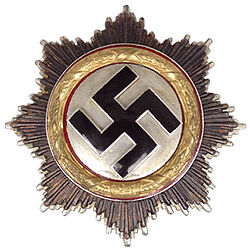Eligibility
The German Cross was issued in two versions: gold and silver (the color of the laurel wreath around the swastika). The gold version was awarded to military personnel for repeated acts of bravery in combat, or of military leadership, with 6–8 acts as a rule of thumb. [3] The silver version was awarded for multiple distinguished services in the war effort and was considered a continuation of the War Merit Cross with swords. Where a recipient had been awarded both the silver and gold versions, only the gold version was authorized for wear.
Article three of the law governing the German Cross states that to qualify for the German Cross in gold or silver, the recipient must be a holder of the Iron Cross (1939) 1st Class or Clasp to the 1914 Iron Cross 1st Class, or the War Merit Cross 1st Class with Swords. The award of the German Cross was not a prerequisite for the award of the Knight's Cross of either the Iron Cross or War Merit Cross, and the German Cross could be awarded to Knight's Cross holders.
While civilians were not eligible, awards could be made to members of uniformed formations including the police and railway workers.
From 30 August 1944, recipients of the gold class of the Close Combat Clasp were normally also awarded the German Cross in gold, without the need for further justification, although the additional award was not made in all cases.
While estimates vary, approximately 25,964 gold and 2,471 silver crosses were awarded. [11]
Appearance
The order consists of a star badge, containing a swastika. It had a diameter of 6.5 centimetres (2.6 in) and was worn on the right-hand side of the tunic.
From June 1942 the gold version was officially available in cloth form, for easier wear on the combat uniform. This had the same dimensions as the original decoration, with the wreath circling the swastika, the only metal part of the badge. The backing cloth reflected the arm of service: field grey for the army, or navy dark blue or air force pale blue.
Twenty specimen copies of a special grade, the German Cross in Gold with Diamonds, were manufactured in 1942, but this grade was never formally instituted or bestowed.
1957 version
The wearing of Nazi-era decorations was banned in Germany after the war, as was any display of the swastika. In 1957, the Federal Republic of Germany authorized the wearing of alternative de-nazified replacement versions of a number of war decorations. These included the German Cross, with the swastika replaced by a representation of the Iron Cross for the gold division, and the War Merit Cross with Swords for the silver division. Qualifying members of the Bundeswehr wore the award on their ribbon bar, represented by a small replica of the decoration on a field grey ribbon.
Award certificate: German Cross in Gold to Count
Claus von Stauffenberg 8 May 1943
Award of a Marine (submarine crew) with the German Cross in Gold (1942)
Worn on chest pocket of the field blouse (Captain Alfred Jaedtke, 1944)
Cloth version worn on Luftwaffe
flight suit (Lieutenant
Siegfried Lemke, 1944)
Worn on the field uniform by an
Oberfeldwebel of the
Großdeutschland Division in Central Russia, 1943
German Cross in Gold (cloth form)
This page is based on this
Wikipedia article Text is available under the
CC BY-SA 4.0 license; additional terms may apply.
Images, videos and audio are available under their respective licenses.








